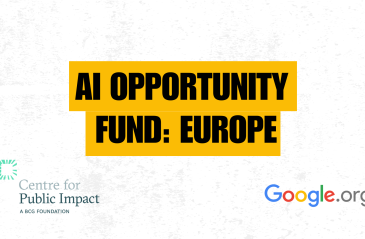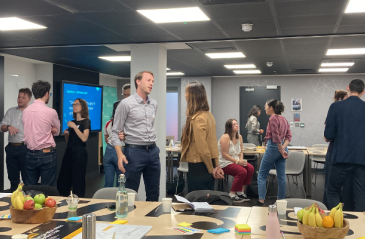
Embracing AI: Empowering vulnerable workers for a more inclusive future

The 'absolute disgrace' of widespread hunger drives the actions and ambitions of @WFPInnovation
Share articleThe work of @WFPInnovation is a crucial lever in the global push to eradicate hunger by 2030
Share articleAI, blockchain and the IoT are all being deployed by @Robert_Opp and his team at @WFPInnovation
Share articleWe put our vision for government into practice through learning partner projects that align with our values and help reimagine government so that it works for everyone.
Sometimes numbers tell a story far better than words. Did you know, for example, that on any given day the United Nations World Food Programme (WFP) has 20 ships, 70 planes and 5,000 trucks on the move, delivering food assistance to those in most need? It's quite a statistic, and one that drives home the scale of global hunger that still haunts communities large and small around the world.
It's a statistic that ensures Robert Opp always gets to work on time - even when having to navigate the traffic-clogged streets of Rome, where he is based. The WFP's director of innovation and change management, Opp says that the "absolute disgrace" of widespread hunger drives the actions and ambitions of the organisation from top to bottom. But he adds that the pressure can sometimes leave little time to take a step back and consider the new ideas and innovations that are necessary to maximise impact - both now and in the future.
"We are in a constant state of crisis, and it takes a lot for the organisation to think about the next step and the next generation," he admits. "It is very difficult to balance the fact that, right now, we have 20 million people affected by imminent famine across four countries, in addition to other large-scale emergencies like the Syria refugee crisis. But while it is certainly hard to prioritise the future over the present, sometimes we have to."
WFP is the leading humanitarian organisation fighting hunger worldwide, delivering food assistance in emergencies, and helping people who cannot produce or obtain enough food for themselves and their families, often in the hardest-to-reach areas. While headquartered in the Italian capital, it has more than 80 national offices around the world.
Opp's role was created two-and-a-half years ago in recognition, he says, of the need to be more systematic about managing innovation. "Although WFP is an innovative organisation and has demonstrated that historically in field operations, innovation was always organic - and organically left to prosper or die," he reflects. "We felt we needed a better way to enable innovations to flourish in the organisation, as well as to bring them in from outside."
He goes on to pinpoint innovation as a crucial lever in the global push to eradicate hunger by 2030. Given that there are almost 800 million hungry people in the world, it is clear there is a need to accelerate progress. Opp, though, remains optimistic. "When you look at the game-changing innovations and technologies now available to us, like big data and mobile technologies - some of which weren't available just a few years ago - you can see how quickly the world can change," he points out. "We want to be at the forefront of this, and really having the maximum impact we can on people's lives."
The primary method of doing so is via a new Innovation Accelerator, much like those found in a tech startup. Based in Munich and funded by the German government, its creation followed a benchmarking of how major companies, public sector entities and other UN agencies approach innovation. "It's about the way you approach new ideas and stay agile," explains Opp. "This new unit has enabled us to support about 25 new innovations over the past 18 months, ranging from developing mobile crowdfunding platforms and designing special nutritious products, to using hydroponic agriculture to be able to grow food anywhere."
Despite the Accelerator's success, Opp is keen to stress that challenges remain. "Our sense was that a lot of the innovations didn't take root because they were under the radar and not enough colleagues in other locations knew about them," he recalls. "We're trying to address that, but there are still bottlenecks to deal with - just as there are in many other large organisations. I am working to create more space and understanding for the risks related to innovation - you can't do innovation without risk."
He goes on to say that the Accelerator is proving to be a good model because it offers a collaborative process, while the person who has the idea still owns the idea. "We don't just sit in a room and shove it out onto the business, or take an idea, build it and take credit for it," he says. "Our function and the Accelerator offer advice, support and mentoring, as well as some of the funding needed to help build out the innovation."
And this building-out phase is where he intends to focus much of his attention going forward. This is because scaling an idea is often the hardest bit. "The number of innovations is fine - I'm pleased with the output - but over the next year or so we need to focus on how to scale," he admits. "Some we are not taking forward but that's part of the process. What we need now are the two to three innovations that can be scaled across different countries and geographies. I won't really be satisfied until that happens."
Asked to identify the lessons learned from the process of setting up the Accelerator, Opp identifies the need for crystal-clear communication, over and above what you might normally expect. "I wish we had known that you can never over-communicate," he says. “Just by having an innovation unit, sometimes people assume that the subliminal message is that they themselves aren't innovative or can't be innovative. So we have really been focusing hard on explaining what we do. But we need to do a lot more of that to increase the knowledge about what the Accelerator offers - not only externally but also within our organisation."
Despite these teething problems - the likes of which are often found in large organisations - the power of WFP's mission, in the end, trumps all. That they live and breathe their work is obvious, although Opp goes on to say that sometimes there simply aren't enough hands on deck or hours in the day.
"We want staff members to come in from our field offices and stay in Munich to focus on innovation projects, but this is hard because their offices don't want to release them as they are so busy, often in remote locations responding to emergencies," he concedes. "But by the same token, we absolutely must stay agile and innovate, because it increases our effectiveness in reaching people who need help the most."
To illustrate his point he cites WFP's ongoing collaboration with the German Aerospace Center (DLR). “We can often come up against barriers that prevent people in desperate need receiving our food assistance," he says. "But our staff are so committed to getting around these issues that we are now in discussions with DLR about using autonomous or remote-controlled vehicles for the purpose of delivering food. So, could we use remote or self-driving trucks in situations where it is too dangerous for a human driver? Or could we use unmanned aerial vehicles for the delivery of food parcels? These are practical actions and are energising in themselves."
And these are just the tip of the technological iceberg. Although the future is still likely to be littered with emergencies and humanitarian disasters, new trends are reshaping our world - and reshaping the future emergency response. "We are looking at smartphone penetration among the entire global population and it is increasing very quickly," he says. "When you match that with universal coverage of the internet, or at least cellphone networks with data access, there will be a revolution in the way people access education material, medical and financial services, instant communication, and so on. This is going to change the way we work and hopefully make us more effective as a result."
And that's not even counting new forces such as artificial intelligence (AI), blockchain and the Internet of Things. "AI can help make everything we do count more for people who need help the most," he explains. "We are trying to figure out how to use machine learning to analyse our data, draw correlations, and figure out what the options are. The faster we can get there, the faster we can help those who are hungry." The low-cost, connected sensors of the Internet of Things, meanwhile, could enable WFP to track individual bags of food, or use ground sensors to look at soil moisture levels and predict the harvest and if there will be drought. And blockchain could help save millions of dollars by authenticating, recording, and reconciling cash and food assistance transactions.
"There is going to be an incredible amount of data available to us," concludes Opp. "But we need to make ourselves agile enough to adopt the best of these trends as they come online, so we reach the people who need our help as fast as possible. It really is that simple."
Opp's desire to make this a reality is palpable. For the sake of the 800 million people who will go to bed hungry tonight, let's hope that he and his team succeed in their endeavours.












